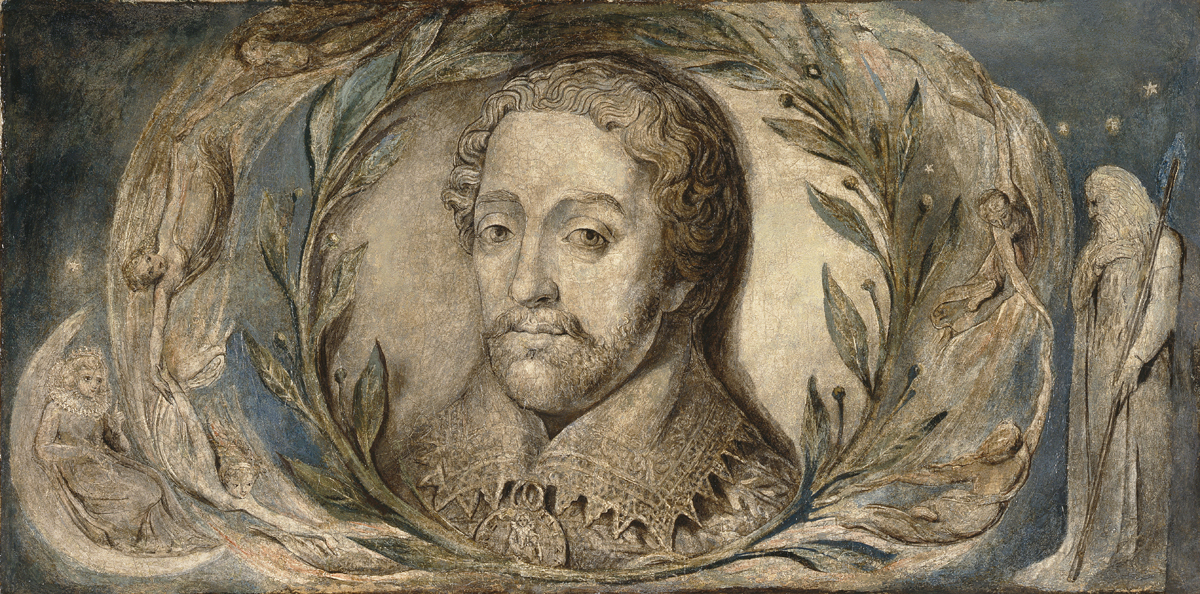 |
The National Trust, Petworth House The Characters in Spencer's Faerie Queene |
When in about 1825 Blake painted a large picture illustrating the
Characters of Spenser's Faerie Queene, he included the minute
detail which Spencer has lavished upon his poem. As usual when
Blake illustrated his predecessors he was commenting on aspects of
their thought with which he agreed and on what he found to be in
error. Spenser was one of the authors whose work Blake found
contained vision even though as an allegory it failed to represent
what Exists in Eternity.
Vision of Last Judgment, (E 554)
"The Last Judgment is not Fable or Allegory
but Vision Fable or Allegory are a totally distinct & inferiorkind of Poetry.
Vision or Imagination is a Representation of
what Eternally Exists. Really & Unchangeably. Fable or Allegory is Formd by the Daughters of Memory. Imagination is Surrounded by the daughters of Inspiration who in the aggregate are calld Jerusalem Fable is Allegory but what Critics call The Fable is Vision itself The Hebrew Bible & the Gospel of Jesus are not Allegory but Eternal Vision or Imagination of All that Exists Note here that Fable or Allegory is Seldom without some Vision Pilgrims Progress is full of it the Greek Poets the same but Allegory & Vision& Visions of Imagination ought to be known as Two Distinct Things & so calld for the Sake of Eternal Life"The Blake Archive has published an article on Blake's The Characters in Spenser’s Faerie Queene. The authors John E. Grant Robert E. Brown have made a detailed analysis of the individuals in the picture which were included in the Faerie Queene. Blake included numerous Spencer characters, many of whom are not clearly visible. As Blake did in his illustration of Chaucer's Canterbury Tales, he portrayed the essential identity of each individual as the author delineated them. Grant and Brown use Blake's illustration to make it possible to grasp a sense of Spenser's allegory through seeing men and women interacting with one another.
Here is a sample from the The Faerie Queene: Book I, Canto I provided by the Poetry Foundation
By Edmund Spenser
lv
The Gutenberg Press published Book 1 of The Faerie Queene edited and introduced by George Armstrong Wauchope. He provides thorough introductory information on the setting, form and content of the work.
Wauchope writes:
"That the allegory of the poem is closely connected with its aim and ethical tendency is evident from the statement of the author that "the generall end therefore of all the booke is to fashion a gentleman or noble person in vertuous and gentle discipline. Which for that I conceived should be most plausible and pleasing, being coloured with an historical fiction, the which the most part of men delight to read, rather for varietie of matter then for profite of the ensample." The Faerie Queene is, therefore, according to the avowed purpose of its author, a poem of culture. Though it is one of the most highly artistic works in the language, it is at the same time one of the most didactic. 'It professes," says Mr. Church, "to be a veiled exposition of moral philosophy.'"
It easy to see how there would be much in Spenser's allegory which would not appeal to Blake's mythopoetic sensibilities.
Elizabeth Jane Darnill, in her thesis submitted to the University of Exeter, titled "Four-fold vision see": Allegory in the Poetry of Edmund Spenser and William Blake makes this statement which clarifies the relationship between imagination, seeing 'thru' the eye, and reading allegory for its visionary content:
"For Blake, the imagination is a continually lived experience, though he is fully aware of the extent to which readers fail to acknowledge and engage with their imaginations. Instead of seeing the “Infinite & Eternal,” readers often confine and limit their minds to the scope of the rational and sensible. A major theme within Blake’s verse, especially in Milton, The Four Zoas and Jerusalem, is the reawakening of the imagination, the awareness of alternative ways of viewing and interpreting. He sought to invite his readers to think and to see more deeply and profoundly. In this sense, the imagination working in partnership with allegory, guides and prompts a greater awareness of multiple levels of viewing. Just as Spenser’s allegorical work encourages readers to use their imagination, Blake’s imaginative verse inspires a deep interrogation of the text and the revelation of the allegorical meanings within it. Readers who see not 'with' but 'through' the eyes are using their minds – their imaginative faculties – when evaluating a scene, rather than relying purely upon the singular dimension of sight when reading the text (“Auguries of Innocence” ll. 125-26). Through allegorical-imaginative didacticism, Blake strives to convey the power of the human imagination."
 |
| Manchester City Gallery Edmund Spenser for William Hayley's Library |
No comments:
Post a Comment